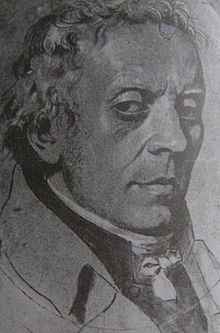Carl Hohnbaum
Carl Hohnbaum (born January 12, 1780 in Coburg , † September 17, 1855 in Hildburghausen ) was a German doctor and publicist .
Life
Carl Hohnbaum was the son of Rodach's superintendent Christian Hohnbaum . After his education at the Gymnasium in Coburg, he studied in Bamberg , Vienna and Jena until 1806 medicine . In 1809 he married Julie Hildebrandt, the daughter of a professor from Erlangen . In 1813 he was elected a member of the German Academy of Sciences Leopoldina .
Hohnbaum first practiced in Rodach and later in Hildburghausen, where he was appointed court medic by Duchess Charlotte . He became the medical officer and councilor in Saxony-Hildburghausen and the first personal physician of Duke Friedrich . After the court moved to Altenburg in 1826, Hohnbaum entered the service of the Duke of Saxony-Meiningen .
As a medical officer, Hohnbaum was obliged in 1819 to work out a draft for the establishment of an " insane asylum " in Hildburghausen, which he fixed in 1828. In it, Hohnbaum propagates a special doctor-patient relationship , the establishment of a smaller, more common psychiatry in which he was concerned with “ preparing convalescents to return to the human community. “Hohnbaum is considered to be one of the most important reformers of the“ treatment of the insane ”in Germany and is regarded as the conceptual founder of today's Specialized Hospital for Psychiatry and Neurology GmbH in Hildburghausen, which was built 11 years after his death.
Carl Hohnbaum was a close friend of Ludwig Nonne , Friedrich Rückert , Carl Barth and Joseph Meyer , who all worked in Hildburghausen. Hohnbaum was Rückert's literary critic and advisor, who occasionally let him review his works before they were published; with Ludwig Nonne he was co-editor of the socially critical village newspaper , for Joseph Meyer, who owed Hohnbaum the relocation of his Bibliographical Institute from Gotha to Hildburghausen, he wrote in whose lexicon the article "doctor" and with Carl Barth and Friedrich Sickler he is considered the discoverer of the tracking plates of the Chirotherium bartii . Hohnbaum published over 100 publications, poems and several books. From 1830 to 1832 he edited the Medicinisches Conversationsblatt together with Ferdinand Jahn - one of the first medical journals.
Fonts (selection)
- About lung stroke flow. Erlangen 1816.
- About the progression of the disease process. Hildburghausen 1826.
- About the pulsation of the epigastric area. Hildburghausen 1837
- Mental health and insanity. Leipzig 1845.
literature
- Günter Auert: From the institution to the clinic. Hildburghausen 1991.
- Helmut Heydenreich: Life and Work of Carl Hohnbaum. Munich 1961.
- G. Auert: [Carl Hohnbaum, the life and work of a distinguished neurologist, founder of the contemporary Hildburghausen District Hospital] . In: Psychiatry, Neurology, and Medical Psychology . tape 27 , no. 6 , ISSN 0033-2739 , p. 366-372 , PMID 1108067 .
Web links
- Carl Hohnbaum on hildburghausen.de
Individual evidence
- ^ Member entry of Karl Hohnbaum at the German Academy of Natural Scientists Leopoldina , accessed on December 1, 2015.
- ^ Günter Auert: From the institution to the clinic. Hildburghausen 1991, p. 28.
| personal data | |
|---|---|
| SURNAME | Hohnbaum, Carl |
| ALTERNATIVE NAMES | Hohnbaum, Karl |
| BRIEF DESCRIPTION | German doctor and publicist |
| DATE OF BIRTH | January 12, 1780 |
| PLACE OF BIRTH | Coburg |
| DATE OF DEATH | September 17, 1855 |
| Place of death | Hildburghausen |

